Having the right knife can make a big difference in your cooking experience. In this blog post, we discuss the 13 different types of knives and their various purposes to help you choose the right one for your kitchen.
Knives are an essential tool in any kitchen. They can make cooking easier, safer, and more enjoyable. With so many different types of knives available, it can be challenging to know which one to use for each task. In this blog post, we will discuss the 13 different types of knives and their various purposes to help you choose the right one for your kitchen.


Table of Contents
A Tool for Every Chef: The Importance of the Right Knife
Having the right knife is crucial for efficient and safe cooking. Using the wrong types of knives for a task can result in uneven cuts, difficulty in chopping, and even accidents. Each knife has a specific purpose and design that is best suited for certain tasks.
For example, a chef’s knife is versatile and can be used for a variety of tasks such as chopping, slicing, and mincing, while a boning knife is designed for precise cuts of meat. It is important to consider the blade material, handle design, and size when selecting a knife that fits your needs. Investing in a quality set of knives will not only improve your cooking experience but also increase the longevity of your knives with proper maintenance.
The Anatomy of a Knife: Understanding the Different Parts


Before diving into the types of knives, it is important to understand the basic parts of a knife. Understanding the different parts of a knife will help you understand the function and purpose of each type of knife.
- Blade: The blade is the sharp, cutting part of the knife. It is usually made of metal and can be straight or serrated.
- Edge: The edge is part of the blade that does the cutting. It is important to keep the edge sharp to maintain the knife’s functionality.
- Point: The point is the very tip of the blade. It can be sharp or rounded, depending on the knife’s purpose.
- Spine: The spine is the non-sharp, opposite side of the blade. It is usually thicker than the edge and can be used to apply pressure or force when cutting.
- Handle: The handle is part of the knife that you hold. It can be made of various materials such as wood, plastic, or metal.
Choosing the Right Knife For You: A Comprehensive Guide
Choosing the right types of knives for your kitchen can make a significant difference in your cooking experience. There are a few factors to consider when selecting a knife, such as the type of food you usually cook, your skill level, and the knife’s handle and blade quality.
The first step is to determine the types of knives you need based on your cooking style. For example, if you prepare a lot of meat dishes, you may need a boning or carving knife. Next, you should look for types of knives with comfortable handles that fit well in your hand. The blade should be made of high-quality steel that is durable and easy to sharpen.
It’s also important to consider the weight and balance of the knife. While there are many types of knives available, a well-balanced knife will make it easier to control the blade and reduce the risk of injury. Finally, you should also consider your budget, as high-quality knives can be quite expensive. However, investing in a good knife and chopping board can save you money in the long run by lasting longer and reducing the risk of accidents.
Kitchen knife
Knives have been present since the dawn of time. They may be used to cook, dress up, fight, and work. Within these broad categories, we may narrow down the precise applications of a kitchen knife. When slicing vegetables, a kitchen knife features a moderate slope that allows you to rock it back and forth. Chef’s knives are not serrated either. Different types of cooking knives include chef knives, Boning Knives, Cleavers, Bread Knife, Paring Knife, and Carving Knife.
Sharp kitchen knives
Because of the carbon concentration in the material, Japanese blades such as Santoku knives are among the sharpest kitchen knives. If properly maintained, it may be the sharpest knife in your knife collection, with powerful, durable, and sturdy blades – ideal for chopping up some ginger or chopped garlic.
Because of their hardness, laminated steel kitchen blades are also sharp kitchen knives. They retain their sharpness for an extended amount of time and are easier to resharpen due to their softer exterior layer.
Chopping knife
A chef’s knife is the best chopping knife for your kitchen and is also used for mincing/dicing/slicing vegetables and herbs, cutting and disjointing big portions of meat, chopping nuts, and crushing whole garlic cloves.
Chopping knife have thicker blades than slicers but are not as hefty as cleavers. Choppers are used to cut, chop, and mince meat, vegetables, and herbs. Choppers are ideal for chopping through tiny soft bones, such as those found in fish and poultry.
Chef Knife
Understanding the many types of knives and their use is an important element of any kitchen. Investing in a decent pair of knives may make or break your efficiency, accuracy, and safety. Each knife has a specific role and may help you take your cooking talents to the next level, from the multipurpose chef knife to the specialised boning knife.
The present age of chef’s knife manufacture may be traced back to 1731 when Peter Henkel established the foundation of what would become a knife empire. So, what distinguishes a German chef knife as “German”? The main point is that it is really difficult. It’s also large and hefty.
Chef’s Knives: The Most Essential Tool in Your Kitchen


The chef’s knife is one of the most versatile types of knives in the kitchen, and it’s also the most commonly used. It is used for chopping, slicing, dicing, and mincing. The blade of a chef’s knife is usually between 6 and 12 inches long and it tapers to a point.
Subtypes of chef’s knives include:
All-Purpose Chef Knife


| Pros | Cons |
| All-Purpose knife | Practice for safe use |
| Multi-usage | Regular sharpening and care |
| Durable due to the material | Not suitable for intricate tasks |
A chef knife is a versatile kitchen tool that is essential for any home or professional chef. With its long, sharp blade and comfortable handle, it can handle a wide range of cutting tasks, from slicing and dicing to chopping and mincing.
Utility Knife
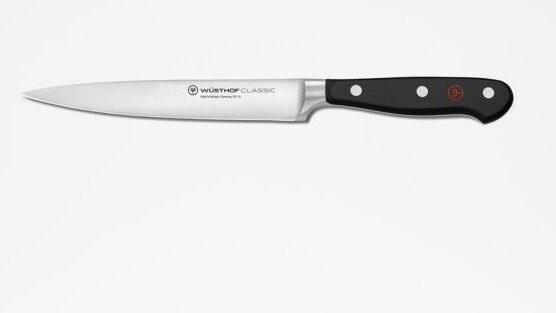

| Pros | Cons |
| Smaller size offers better control and precision. | Not ideal for heavy-duty tasks like cleaving. |
| The compact design makes it great for outdoor cooking. | May not handle longer cuts as well as larger knives. |
| Generally lower cost compared to specialised knives | Not for All Foods |
A utility knife is smaller than a chef’s knife and is typically used for tasks that require more precision, such as trimming and slicing small vegetables and fruits.
Paring Knife


| Pros | Cons |
| Handles small fruits, veggies, and delicate jobs well. | Limited Utility |
| Perfect for creating decorative garnishes. | Fragility |
| Suitable for cooks of all skill levels. | Often used as a complement to other knives |
A paring knife is the smallest knife in the kitchen and is used for tasks that require a lot of control, such as peeling and coring.
Bread Knife


| Pros | Cons |
| Clean Slicing | Limited Use |
| Minimal Crumbs | Longer blades might be less manoeuvrable for some users |
| Allows controlled, even slices of various thicknesses | Serrated edges can be challenging to sharpen at home. |
A bread knife is used for slicing bread and has a serrated edge that makes it easy to cut through the crust without crushing the soft interior.
Meat Knives: The Perfect Cut for Your Meat


Meat knives are types of knives used for cutting and preparing different types of meat. They have thicker, sturdier blades that can handle tough cuts of meat.
Subtypes of meat knives include:
Boning Knife


| Pros | Cons |
| Ideal for deboning and filleting | Thin blade might not handle heavy-duty chopping well |
| Can also handle tasks like trimming fat and skin. | Regular sharpening is necessary for effective use |
| Used by chefs for specialized meat preparation | Limited Use |
A boning knife is used to separate meat from the bone, and it has a thin, flexible blade that allows for precision cuts.
Cleaver
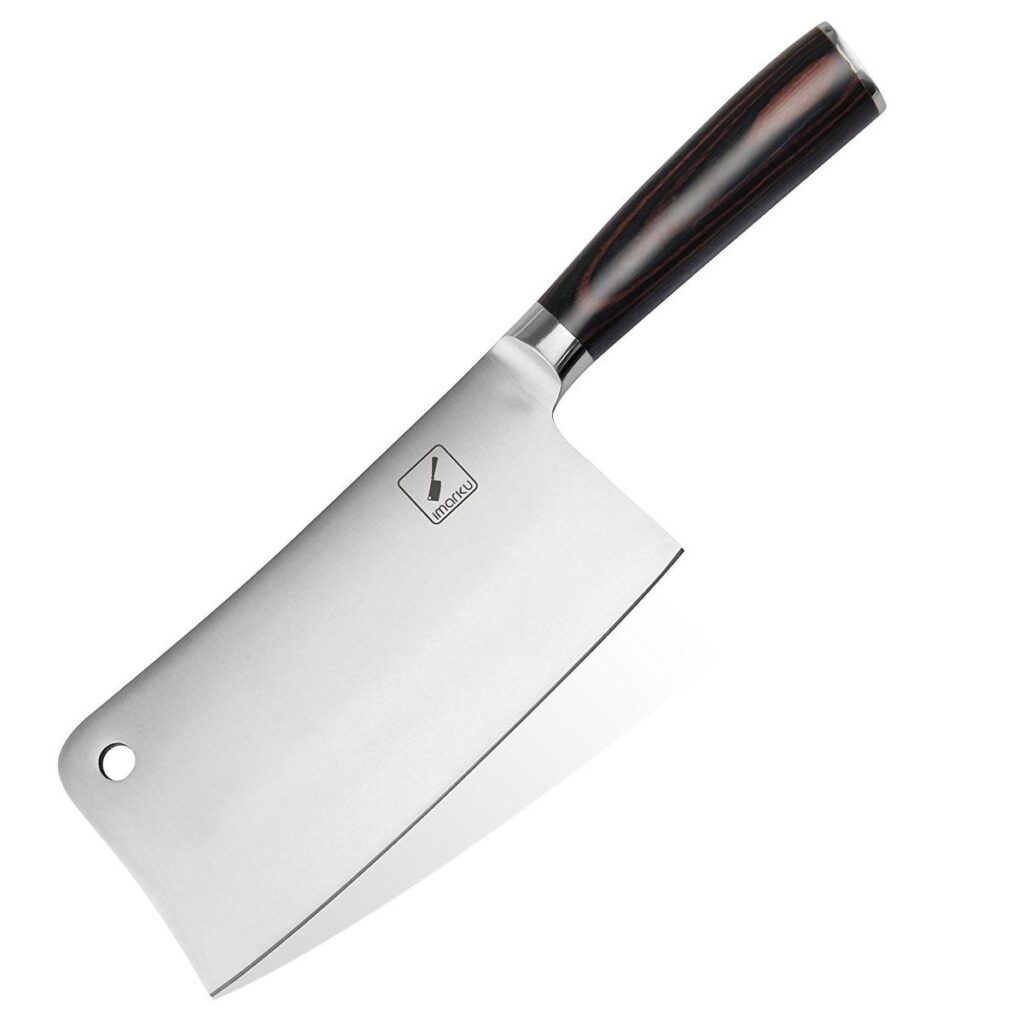

| Pros | Cons |
| Multipurpose | Less effective for delicate tasks or precision cutting |
| A bulky design might require dedicated storage space | Heavier than other knives, requiring more effort |
| Sturdy build withstands demanding kitchen tasks | Bulky design might require dedicated storage space |
A cleaver is a large, heavy knife that is used for chopping through bones and tough meat.
Butcher/Carving Knife
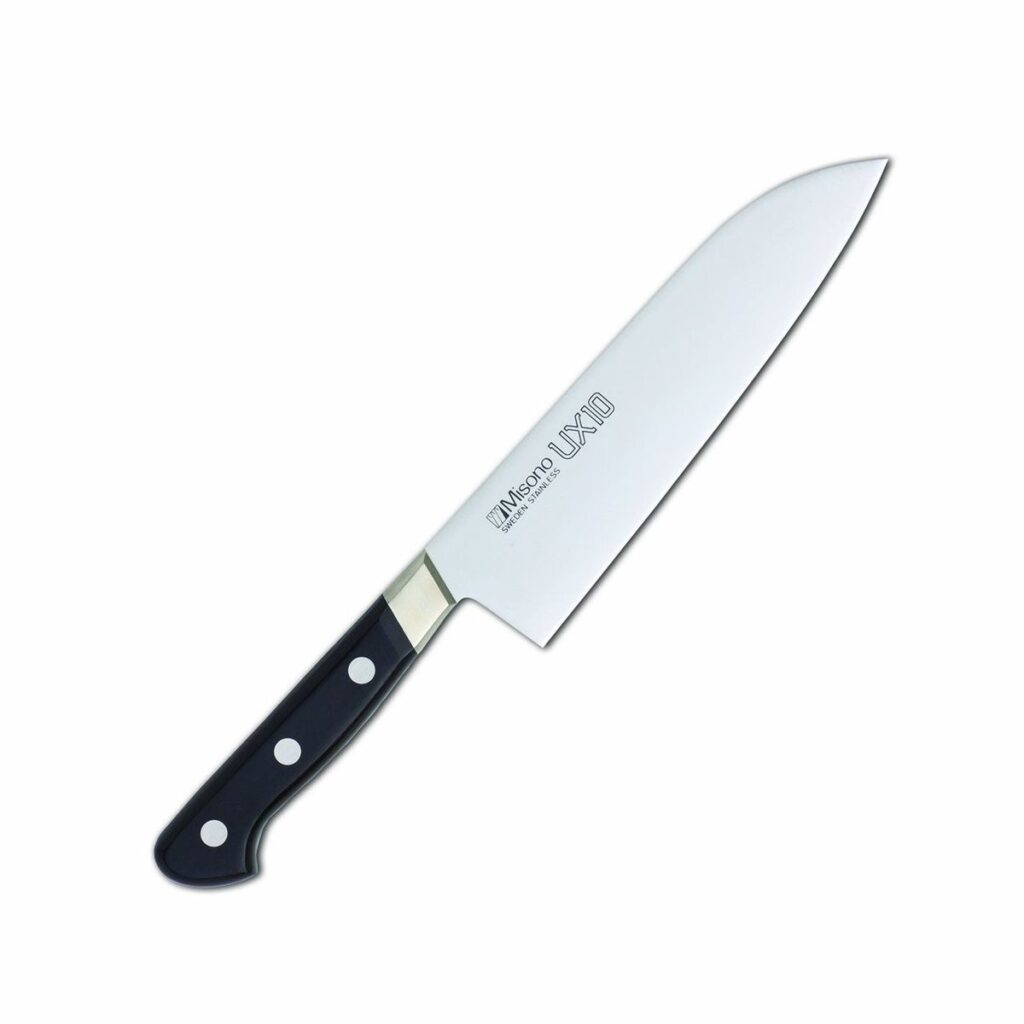

| Pros | Cons |
| Creates impressive, uniform slices for attractive servings | Longer blade requires proper storage to avoid damage. |
| Reduces effort with its sharpness and blade design. | Not for all food. |
| Essential for professional-looking carving and slicing. | May not replace other knives for general kitchen tasks |
A butcher or carving knife is used for slicing meat, and it has a long, thin blade that makes it easy to make clean, precise cuts.
Fish Knives: Preparing and Filleting Fish with Precision
Fish knives are types of knives used for filleting and preparing fish. They have flexible blades that can easily glide over the bones and skin of the fish.
Subtypes of fish knives include:
Salmon Knife
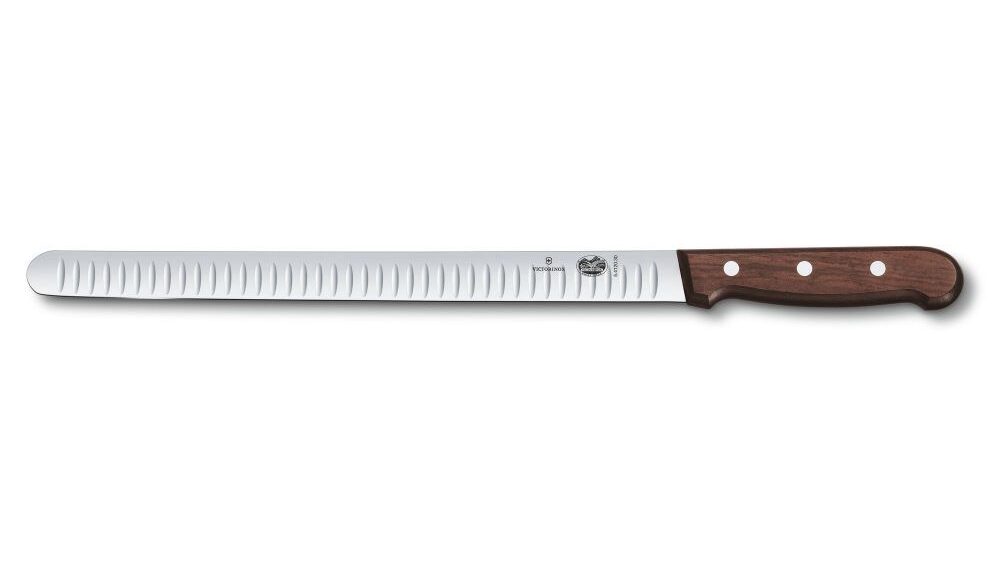

| Pros | Cons |
| Thin, flexible blade is designed for precise filleting of fish. | Regular sharpening is necessary for effective use |
| Saves time by cleanly separating the skin from the flesh. | Not an all-purpose knife |
| Reduces meat wastage during filleting. | Demands proper knife skills, making it challenging for beginners. |
A salmon knife is used for filleting salmon, and it has a long, narrow blade that makes it easy to make precise cuts.
Filleting Knife


| Pros | Cons |
| Suitable for delicate tasks such as trimming and peeling. | Regular sharpening is necessary to maintain its precision. |
| Creates clean cuts, minimizing meat wastage. | May not be the most versatile knife for general kitchen tasks. |
| Used by chefs for specialized seafood preparation. | Due to its thinness, the knife requires careful handling to prevent bending or breaking. |
A filleting knife is used for filleting all types of fish, and it has a thin, flexible blade that can easily remove bones and skin.
Vegetable Knives: The Must-Have Tools for All Your Veggie Needs


Vegetable knives are the types of knives used for cutting and preparing different types of vegetables. They have a shorter blade that makes it easier to handle smaller vegetables.
Subtypes of vegetable knives include:
Peeling Knife


| Pros | Cons |
| Narrow, pointed blade is perfect for peeling and trimming. | Due to its small size, it might require careful storage to prevent damage. |
| Ideal for tasks like removing fruit skins and creating garnishes. | Additional knives might still be needed for larger or diverse cutting tasks. |
| Suitable for all skill levels, including beginners. | Regular sharpening is crucial to maintain the knife’s precision. |
A peeling knife is used for peeling vegetables and fruits, and it has a short, curved blade that makes it easy to remove the skin.
Tomato Knife


| Pros | Cons |
| Serrated blade easily cuts through delicate tomato skin without crushing the flesh. | Might not replace other knives for general kitchen needs. |
| Allows controlled, thin slices for attractive presentations. | Sharpening serrated blades can be more challenging. |
| Reduces juice and seed splatter due to its serrated design. | Proper storage is needed to prevent damage to the delicate serrated edge. |
A tomato knife is used for slicing tomatoes, and it has a serrated edge that makes it easy to cut through the skin without crushing the flesh.
Santoku Knife
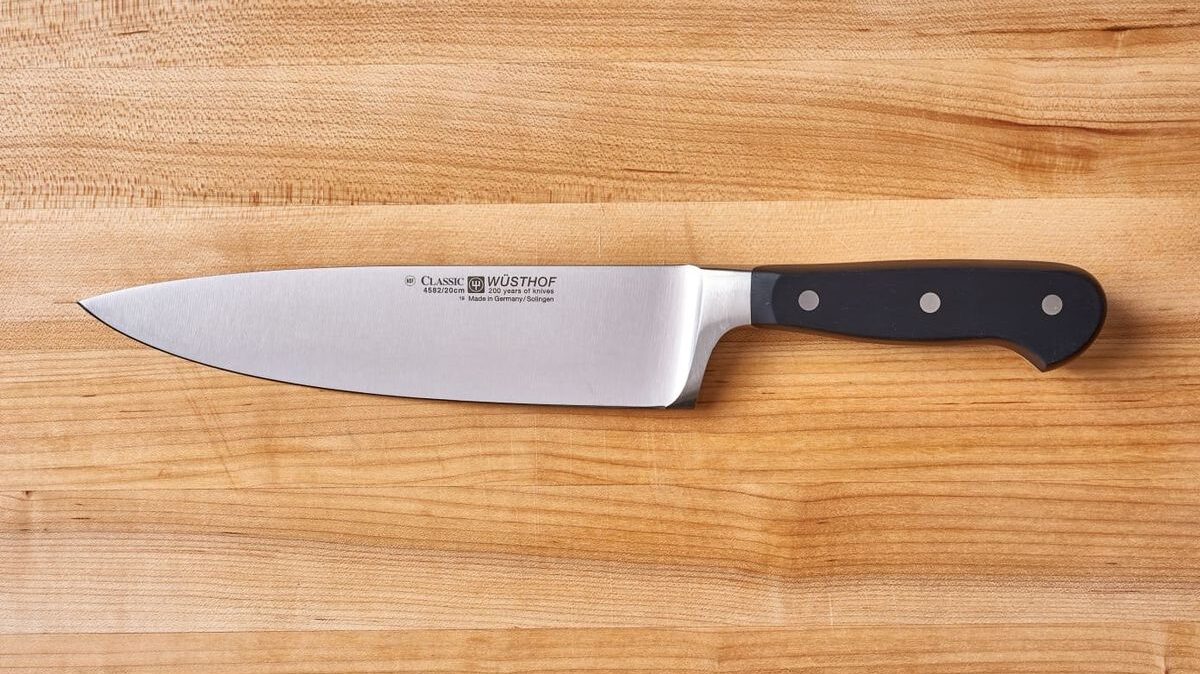

| Pros | Cons |
| Allow controlled cuts for consistent results. | Thicker ingredients may require more force to cut through. |
| Can handle various ingredients, making it a go-to knife. | Mastery of technique is important for optimal performance. |
| Ergonomic design reduces hand fatigue during prolonged use. | Sharpening can be more challenging due to its unique edge design. |
A santoku knife is a Japanese-style knife that is used for slicing, dicing, and chopping vegetables, meat, and fish. It has a shorter blade than a chef’s knife and a straighter edge.
Nakiri Knife
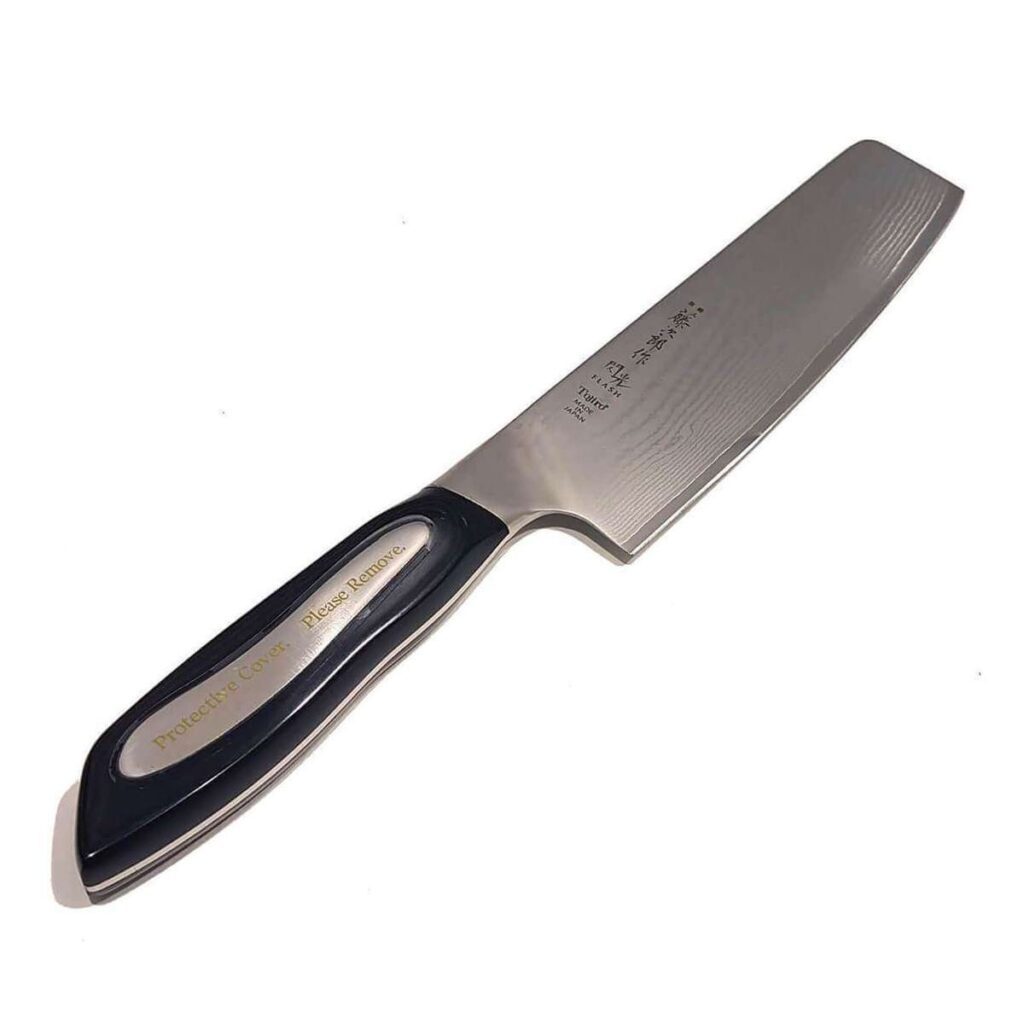

| Pros | Cons |
| Designed for precise vegetable slicing, chopping, and dicing. | Might struggle with harder or thicker ingredients. |
| A wide, flat blade offers excellent surface contact for quick tasks. | Proper technique is crucial for safe and effective use. |
| A flat blade aids in efficient up-and-down chopping motions. | May not handle larger ingredients as efficiently as longer knives. |
A nakiri knife is also a Japanese-style knife that is used for slicing and chopping vegetables. It has a straight blade that makes it easy to make precise cuts.
Types of Knife Edges
There are three main types of knife edges: granton edge, straight (or smooth) edge, and serrated edge. The type of knife edge you will want on your kitchen knife will largely depend on the food you are cutting.
Granton Edge


- Creates air pockets between the blade and food for more fluid slicing.
- Prevents wet and sticky foods from sticking to the blade after each cut.
Straight Edge
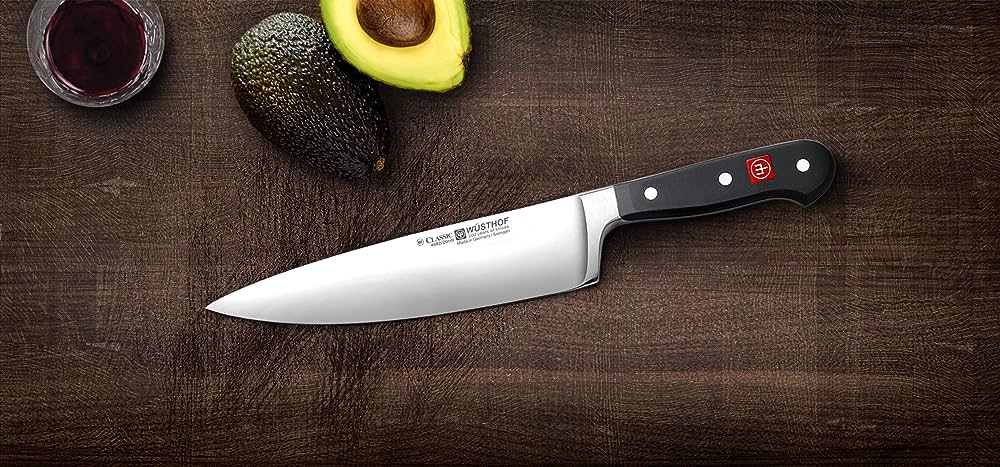

- Makes smooth, clean cuts with a few simple strokes.
- Best for hard and soft fruits, vegetables, and meats.
Serrated Edge


- Saw through items with a hard exterior and son interior while keeping them intact.
- Best for bread, cakes, and produce with skin
Different types of knives
There are three different types of knives handle styles: plastic, stainless steel, and wooden. A comfortable, secure grip is the most crucial feature to seek in a good knife handle. Among the many knife handle styles, plastic and wood handles are the most prevalent in kitchen knives, whereas stainless steel handles are more frequent in table knives.
Knife Handle Styles
Knife handles are classified into three types: plastic, stainless steel, and wooden. A comfortable, secure grip is the most crucial feature to seek in a good knife handle. The most popular handle materials for kitchen knives are plastic and wood, whereas stainless steel handles are more frequently for table knives. While wood is the most traditional handle material used for kitchen knives and provides unrivalled balance, durability, and appearance, it does require more maintenance and may not be the best choice for your business setting.
Plastic Handle
- Durable, lightweight, and easy to clean. and economic.
- Provide a comfortable, stable grip.
- Come in many types like nylon, resin, and POM
Wood Handle
- Attractive and comfortable to use
- Naturally non-slip
- Harder to clean and can trap bacteria
Stainless Steel Handle
- Very durable and easy to clean
- Provide balance and weight for table knives
- Can become slippery when wet
A Comparative Look at 13 Types of Knives: Which One is Right for You?
Choosing the right types of knives for you can be tricky. We’ve added a table comparing knife subtypes by purpose, utility, maintenance, and other relevant factors:
| Knife Subtype | Purpose | Utility | Maintenance | Other Factors |
| Chef’s Knife | All-purpose knife for chopping, slicing, and dicing | Versatile, can handle most kitchen tasks | Regular sharpening, hand washing | Blade length is 8-10 inches |
| Utility Knife | Mid-sized knife for smaller tasks such as trimming, peeling, and slicing | Easily manoeuvres around bones | Regular sharpening, hand washing | Blade length is 4-7 inches |
| Paring Knife | Small knife for peeling and coring fruits and vegetables | Precise, good for detailed work | Regular sharpening, hand washing | Blade length is 3-4 inches |
| Bread Knife | Serrated knife for slicing bread and other baked goods | Easily cuts through crusts without crushing the interior | Regular sharpening, hand washing | Blade length is 8-10 inches |
| Boning Knife | Knife for removing meat from bones | Flexible blade for getting into tight spaces | Regular sharpening, hand washing | Blade length is 5-7 inches |
| Cleaver | Heavy-duty knife for chopping through bones and tough meats | Can also be used for crushing garlic and other tasks | Regular sharpening, hand washing | Blade length is 6-8 inches |
| Butcher/Carving Knife | Long, thin knife for slicing roasts and other meats | Creates even slices with minimal shredding | Regular sharpening, hand washing | Blade length is 8-12 inches |
| Salmon Knife | Long, thin knife for filleting and slicing fish | Creates even slices with minimal shredding | Regular sharpening, hand washing | Blade length is typically 8-12 inches |
| Fillet Knife | Flexible knife for filleting fish | Easily maneuvers around bones | Regular sharpening, hand washing | Blade length is 6-9 inches |
| Peeling Knife | Small knife for peeling and trimming fruits and vegetables | Precise, good for detailed work | Regular sharpening, hand washing | Blade length is 2-3 inches |
| Tomato Knife | Serrated knife for slicing through the tough skin of tomatoes | Easily slices through soft flesh without crushing it | Regular sharpening, hand washing | Blade length is 4-6 inches |
| Santoku Knife | All-purpose Japanese knife for chopping, slicing, and dicing | Combines the features of a chef’s knife and a vegetable knife | Regular sharpening, hand washing | Blade length is 5-7 inches |
| Nakiri Knife | Japanese vegetable knife for slicing and chopping | Has a thin blade for precise cuts | Regular sharpening, hand washing | Blade length is 5-7 inches |
Conclusion
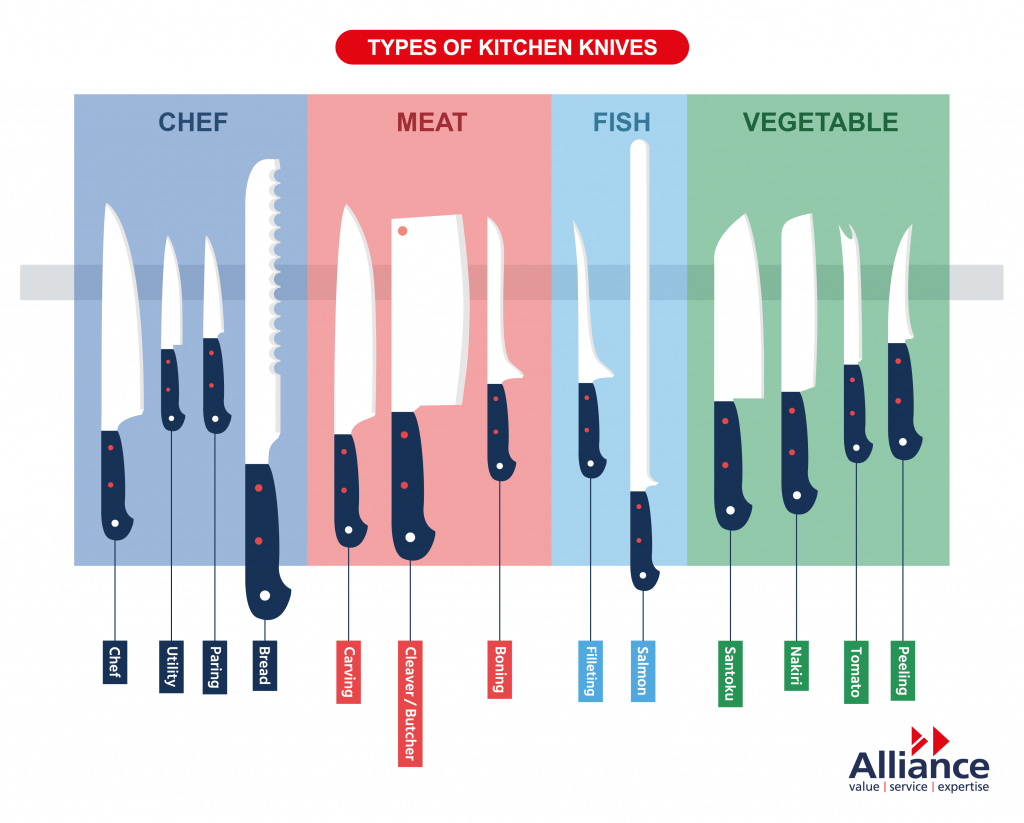

Understanding the various types of knives and their purposes is an essential aspect of any kitchen. Investing in a good set of knives can make all the difference in terms of efficiency, precision, and safety. From the versatile chef’s knife to the specialized boning knife, each knife serves a unique purpose and can help elevate your cooking skills to the next level.
It’s also important to remember that maintaining your knives properly can help them last longer and perform better. Whether you’re a professional chef or a home cook, having a range of knives at your disposal can help you achieve your culinary goals with ease. So, go ahead and experiment with different types of knives to find the perfect match for your cooking style and needs. Add these knives to your utensil stand and experience the difference!
FAQs- Types of Knives
To sharpen kitchen knives, you can use a sharpening stone, honing rod, or an electric knife sharpener. A sharpening stone is the most traditional method, where you rub the blade against a stone at a specific angle until it is sharpened. A honing rod is used to maintain the sharpness of the blade by realigning it. An electric knife sharpener is a convenient and quick option for sharpening, but it may not provide the precision of a sharpening stone or honing rod. It is important to follow the manufacturer’s instructions and take necessary safety precautions while sharpening your types of knives.
There are various types of knives available in the market, but the commonly recognized ones are chef’s knife, utility knife, paring knife, bread knife, boning knife, fillet knife, carving knife, and cleaver.
There are about a dozen different types of kitchen knives that are usually seen in a Western kitchen. Chef, paring, and bread knives are the most often used cutlery. Either way, understanding the different types of kitchen knives and how to use them can open up a whole new world.
Types of knife in the kitchen provide a variety of functions for culinary chores such as slicing, dicing, and carving.
To guarantee accurate and safe cutting in the kitchen, pick the proper knife for each work from the numerous types of knife in kitchen
The four commonly used types of knives in the kitchen are the chef’s knife, paring knife, utility knife, and bread knife.
All types of knives ever made include work Knives, Diver’s knives, Electrician’s Knife, Carpenter’s Knife, Hunting Knives, Scalpel, Multitools, Machete, Kukri, Balisongs, X-Acto Knife, Pocket Knife, Survival Knife, Combat Knives, Recreational Knives, and Cooking knives. Out of all types of knives, a chef’s knife is the most versatile and is best suited for home use. It is a multipurpose knife that can be used for chopping, slicing, dicing, and mincing.
Out of all types of knives, a chef’s knife is the most versatile and is best suited for home use. It is a multipurpose knife that can be used for chopping, slicing, dicing, and mincing. A chef’s knife usually has a blade length of 8-10 inches and is available in various shapes and designs.
A Santoku knife is a Japanese-style knife that is used for chopping, slicing, and dicing. It is similar to a chef’s knife but has a shorter and wider blade, allowing for a more efficient chopping motion. The Santoku knife is a popular choice for preparing vegetables, meat, and fish.

[…] a sharp knife is more dangerous than a dull one: A sharp knife is actually safer than a dull one because it […]